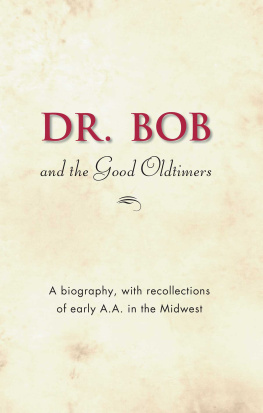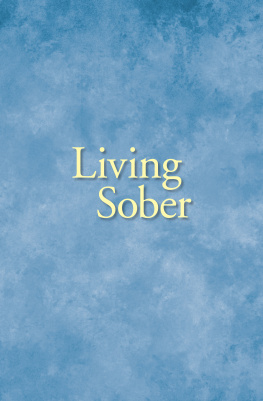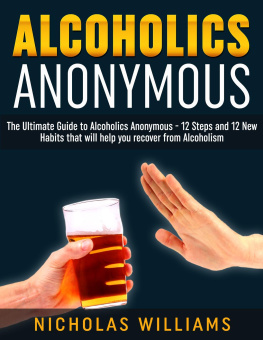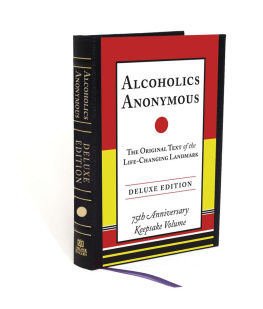DR. BOB
and the Good Oldtimers
DR.BOB
and the
Good
Oldtimers
A biography, with recollections
of early A.A. in the Midwest
1980
Alcoholics Anonymous World Services, Inc., New York, N.Y
DR. BOB AND THE GOOD OLDTIMERS
Copyright 1980 by
ALCOHOLICS ANONYMOUS WORLD SERVICES, INC.
475 Riverside Drive
New York, N.Y. 10115
All rights reserved. No portion of this publication may be
reproduced in any manner without the written permission
of the publisher.
First Printing 1980
Thirtieth Printing 2013
This is A.A. General Service Conference-approved literature
ALCOHOLICS ANONYMOUS and A.A. are registered
trademarks of A.A. World Services. Inc.
www.aa.org
ISBN 978-0-916856-07-6
eISBN 978-1-940889-80-1
Printed In The United States Of America
B-8
| Contents |
| I. |
| II. |
| III. |
| IV. |
| V. |
| VI. |
| VII. |
| VIII. |
| IX. |
| X. |
| XI. |
| XII. |
| XIII. |
| XIV. |
| XV. |
| XVI. |
| XVII. |
| XVIII. |
| XIX. |
| XX. |
| XXI. |
| XXII. |
| XXIII. |
| XXIV. |
| XXV. |
| XXVI. |
| XXVII. |
| XXVIII. |
| XXIX. |
Foreword
The preparation of this book began after the April 1977 A.A. General Service Conference approved the project. Originally, a joint biography of the two co-founders was planned. When this proved impracticable, it became apparent that Dr. Bobs biography should be written first, before Bill W.s.
The end of the last century was the setting for all of Dr. Bobs childhood and youth. Even with the most thorough research, this early period includes months and years of which only the barest account can be given, and that in the memories of but a few men and women. Undramatic as these recollections are, they give glimpses into the innate character that would help to shape the Fellowship of Alcoholics Anonymous.
For Dr. Bobs adult yearsas an active and then as a recovering alcoholicthe material is far richer. In the course of research, the book naturally expanded from biographical limits into a memoir of early A.A. in the Midwest. Our co-founder was in the same position as any other A.A. member: Without the Fellowship and its program, his life would have been only a short story with a tragic ending.
Both the individual and the larger history unfolded partially from A.A. literature and material in the archives at the A.A. General Service Office in New York Citybut chiefly from face-to-face talks with relatives, friends, and acquaintances of Dr. Bob and with pioneer members of Midwestern A.A. The locales of these interviews included, not only Ohio and Dr. Bobs native Vermont, but California, the D.C. area, Florida, North Carolina, New York, and Texas.
The interviews yielded a greater wealth of historical material than could be included in one book; but the complete records are now in the A.A. archives. To all the people who shared their memories, the Fellowship owes a debt of gratitude.
Thirty years after two alcoholics met in Akron, this huge throng at the A.A. International Convention in Toronto, Ontario, joined in saying words that sum up the spirit behind the worldwide growthof A.A., before and since: I am responsible. When anyone, anywhere, reaches out for help, I want the hand of A.A. always to be there. And for that: I am responsible (preceding pages).
I. Childhood and college years
Robert Holbrook Smitheventually to be known to grateful alcoholics as Dr. Bob, co-founder of Alcoholics Anonymouswas born August 8, 1879, in the front bedroom of a large, 19th century clapboard house at Central and Summer Streets in St. Johnsbury, Vermont.
He was the son of Judge and Mrs. Walter Perrin Smith. Influential in business and civic affairs, Judge Smith sat on the Caledonia County (Vermont) Probate Court. He was also, at various times, states attorney, member of the state legislature, superintendent of St. Johnsbury schools, director of the Merchants National Bank, and president of the Passumpsic Savings Bank. In addition, he taught Sunday school for 40 years.
Dr. Bob, who rarely discussed family background, described his father as being a typical Vermont Yankeereserved and taciturn on first acquaintance, with a lively if somewhat dry sense of humor.
Many years later, Dr. Bobs son, Robert R. Smith (nicknamed Smitty), was to describe his father in much the same way. Upon your first contact, he was very reserved and formal in his relationships, but when you became his friend, he showed a personality which was just the oppositefriendly, generous, and full of fun, Smitty said.
Under the granite surface, Judge Smith betrayed a good deal of warmth and compassion, with perhaps a touch of indulgence, toward his only son. Certainly, he made an attempt to understand and control the malady that threatened to destroy Bobs life and work. Many times, with varying degrees of temporary success, he tried to rescue Bob from the effects of his drinking. Unfortunately, Judge Smith, who died in 1918, did not live to see Dr. Bob attain permanent sobriety.
Mrs. Smith, who did live to see Dr. Bob get sober, was described as a stern, tight-lipped, churchgoing lady who busied herself with the countless social and religious activities of St. Johnsburys towering, gray stone North Congregational Church.
Grandma Smith was a cold woman, said Suzanne Windows, Dr. Bobs adopted daughter. Once, she came to the house, and we were all sick with the flu. Instead of pitching in, she went to bed, too!
Mrs. Smith felt that the way to success and salvation lay through strict parental supervision, no-nonsense education, and regular spiritual devotion.
Mom [Anne Ripley Smith] blamed her for Dads drinking, said Sue. She felt the stern upbringing nearly ruined him. When he got the chance, he just broke loose.
Dr. Bob (who, as we know, was not one to louse it all up
Healthy Vermont boyhood behind him, medical career ahead,
young Dr. Bob already had a second careeralcoholic.

with Freudian complexes) merely said, I just loved my grog. But he could look back and see certain long-range influences in his childhood.
Although he had a much older foster sister, Amanda Northrup, of whom he was quite fond, he grew up as an only child. In his middle years, Dr. Bob said he considered this unfortunate, because it may have engendered the selfishness which played such an important part in bringing on my alcoholism.
And he did find one source of future rebellion: From childhood through high school, I was more or less forced to go to church, Sunday school and evening service, Monday-night Christian Endeavor, and sometimes to Wednesday-evening prayer meeting, he recalled. This had the effect of making me resolve that when I was free from parental domination, I would never again darken the doors of a church. Dr. Bob kept his resolution steadfastly for the next 40 years, except when circumstances made it unwise.
Another sign of rebellion came at an early age. Young Bob was sent to bed every evening at five oclock. He went with a quietly obedient air that might have led some parents to suspect the worst. When he thought the coast was clear, Bob got up, dressed, and slipped stealthily downstairs and out the back door to join his friends. He was never caught.









